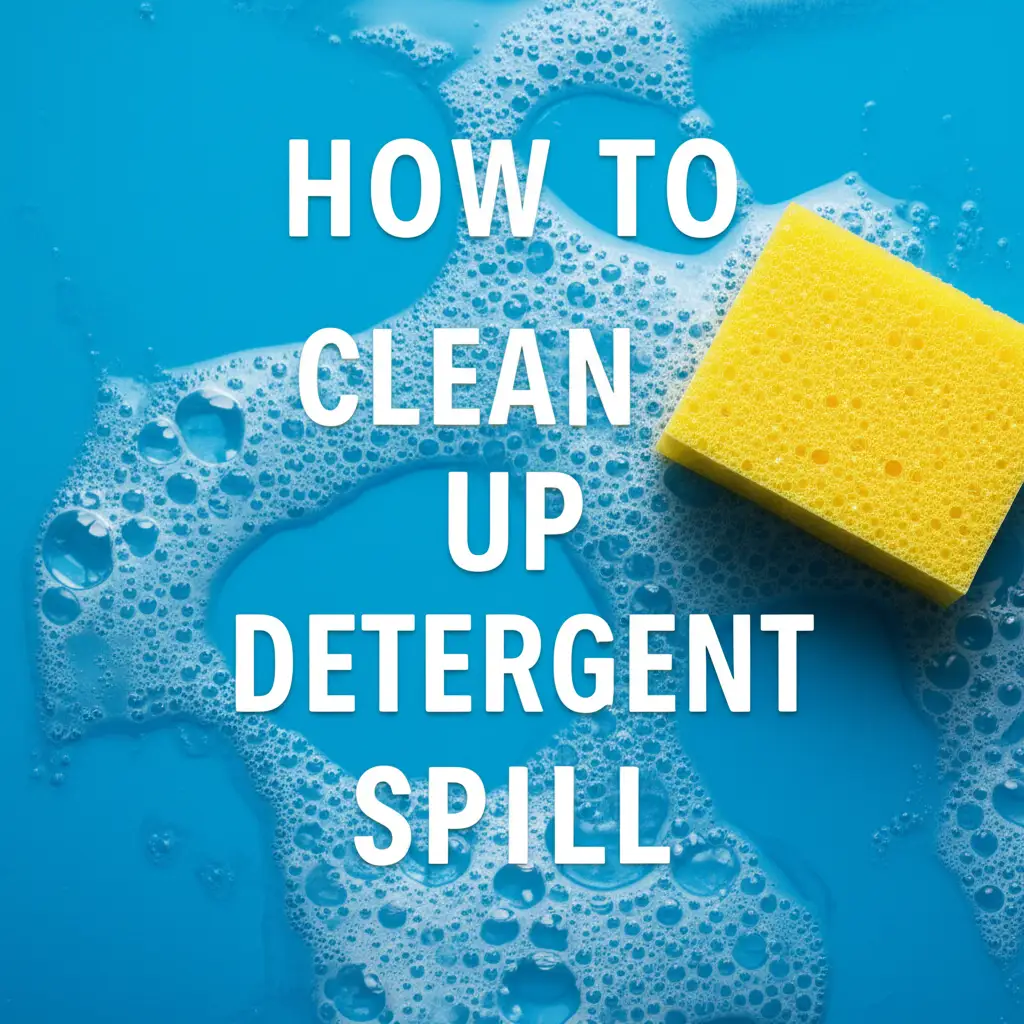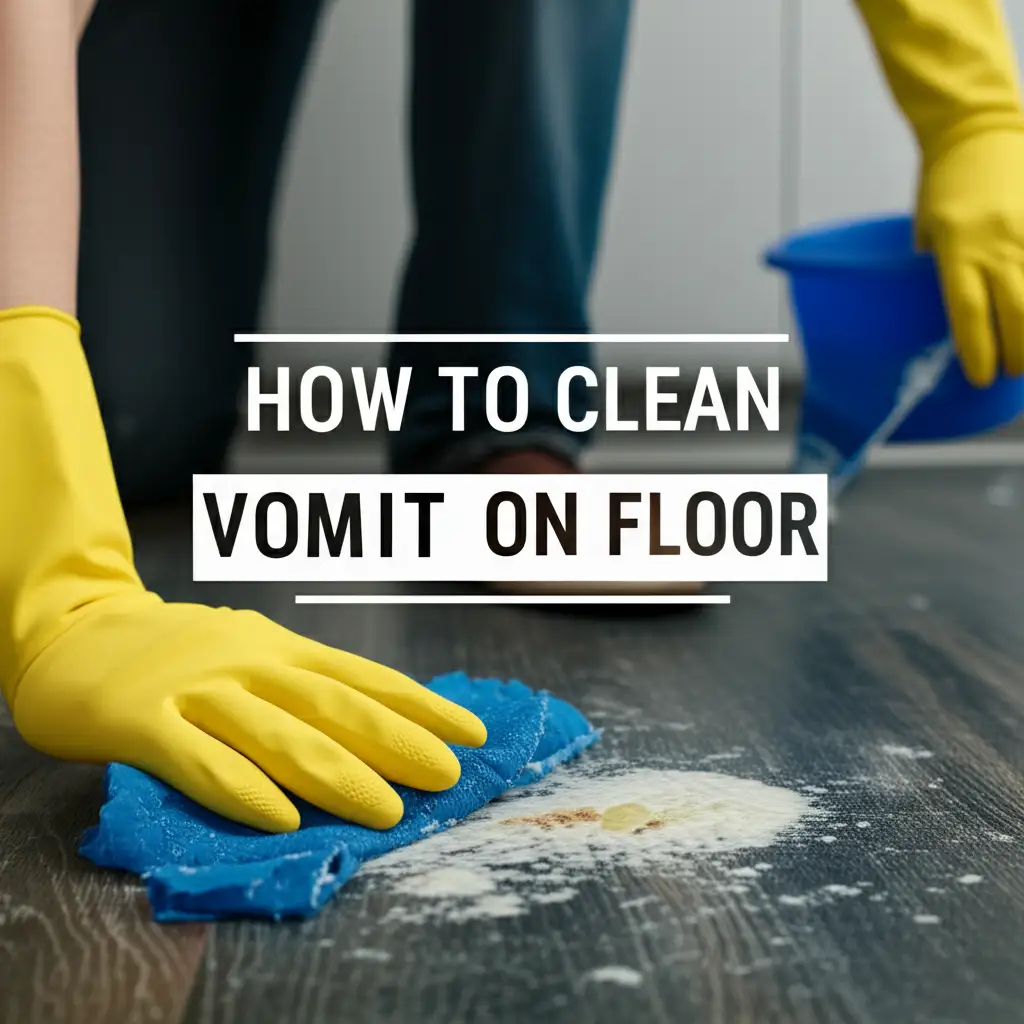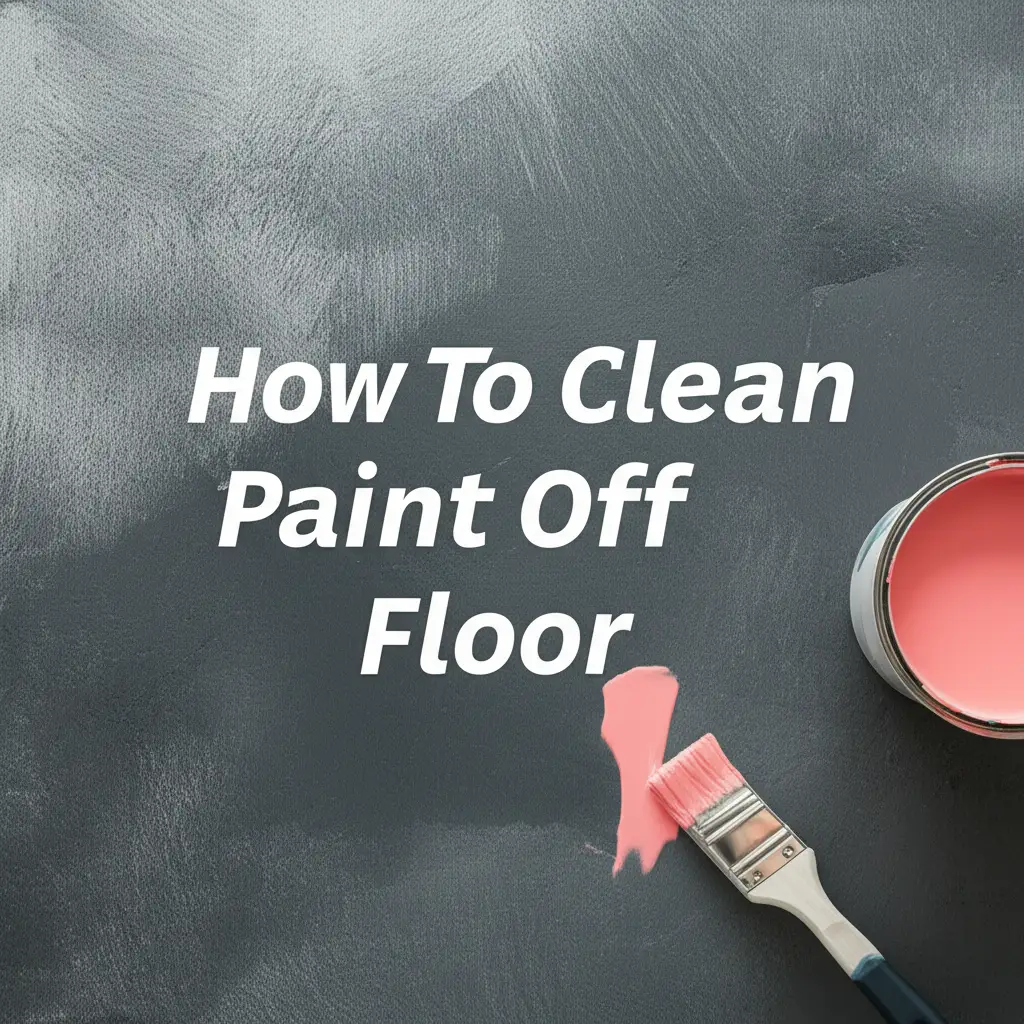· Home Cleaning · 17 min read
How To Clean Up Detergent Spill

Dealing with a detergent spill can be quite a mess. It creates slippery floors and leaves behind a sticky residue. Whether it is a small dribble or a large pool, knowing the right steps helps you clean it up effectively. This guide helps you tackle any detergent spill. We cover both liquid and powder spills on different surfaces.
Takeaway
- Act fast to contain the spill.
- Prioritize safety by protecting yourself and others.
- Use absorbent materials for liquid spills and a vacuum for powder.
- Clean the area thoroughly to remove all residue.
- Ensure the surface is dry and free of slipperiness.
A detergent spill requires quick action. First, protect yourself and others by securing the area. Then, absorb the bulk of the spill with towels or cat litter. Finally, clean the remaining residue with water and a clean cloth. This prevents slippery surfaces and sticky buildup.
Immediate Steps: Safety First When Cleaning Detergent Spills
A detergent spill creates a slippery surface. This creates a fall hazard. Your immediate response should focus on safety. Protect yourself and others from injury. This helps prevent further damage.
First, identify the type of detergent spill. Is it liquid or powder? Liquid detergent spreads quickly and makes surfaces very slick. Powdered detergent can become airborne. It can also form a paste when wet. Knowing the type helps you choose the right approach.
Next, secure the area. Place warning signs if possible. Tell family members or pets to stay away. This prevents accidental slips or contact with the detergent. Consider wearing gloves and eye protection. Detergent can irritate skin and eyes. If you have a large spill or are sensitive, wear proper gear.
Ventilation is also important. Open windows and doors. This helps fresh air circulate. It reduces strong detergent fumes. Strong fumes can cause respiratory irritation. Good airflow makes the cleanup process safer. Your quick, safe actions make a big difference.
Do not allow the spill to spread. Try to contain it immediately. For liquid spills, create a barrier. Use old towels or rags around the edges of the spill. This stops it from reaching other areas. For powder spills, avoid sweeping. Sweeping can spread the powder. It can also create dust clouds. These initial steps set the stage for a cleaner, safer outcome.
Essential Tools and Materials for Detergent Spill Cleanup
Gathering the right tools before you start cleaning makes the process smoother. You need specific items for both liquid and powder detergent spills. Having everything ready saves time. It helps ensure a thorough cleanup.
For liquid detergent spills, you will need absorbent materials. Old towels, rags, or paper towels work well. Cat litter is also very effective for large liquid spills. It soaks up liquids quickly. You also need a bucket of clean water. Have a mop or several clean cloths ready for rinsing. A squeegee might be helpful on smooth floors. Finally, have a dry mop or more clean towels for drying the area.
For powder detergent spills, a vacuum cleaner is essential. A shop vacuum is best if you have one. It handles dry spills and potential moisture well. A broom and dustpan can also work. Be careful not to create dust clouds with a broom. You will also need a bucket of clean water and rags for wiping. A scrub brush can help with any residue.
For both types of spills, keep a few general items handy. Wear rubber gloves to protect your hands. Eye protection is also wise. Have a trash bag ready for soiled materials. This ensures proper disposal. A fan can help with drying the area faster. Having these tools prepared prevents delays. It helps you clean the detergent spill effectively and safely.
Step-by-Step Guide: Cleaning Liquid Detergent Spills
Cleaning liquid detergent requires a careful approach. Liquid detergent spreads fast. It also creates extremely slippery surfaces. Follow these steps to clean the spill effectively. This ensures safety and removes all residue.
1. Contain and Absorb the Bulk: Act quickly to stop the spread. Place old towels or rags around the edges of the spill. This creates a dam. For larger spills, pour cat litter directly onto the spill. You can also use sawdust or cornmeal. These materials absorb the liquid. Let the absorbent material sit for several minutes. This gives it time to soak up the detergent. Once absorbed, scoop up the material. Dispose of it in a trash bag. You want to remove as much liquid as possible this way.
2. Scrape Up Remaining Detergent: Some liquid detergent might remain. It may be thick or sticky. Use a squeegee or a sturdy piece of cardboard. Gently scrape up any remaining detergent. Direct it into a dustpan or onto more absorbent towels. This step reduces the amount of residue. It prepares the surface for the next cleaning phase.
3. Rinse the Area Thoroughly: Detergent leaves a residue. This residue makes surfaces slippery. It also attracts dirt. Fill a bucket with clean, warm water. Do not use too much water at once. You do not want to spread the spill again. Use a clean mop or a cloth. Dampen it with water. Wipe the affected area. Rinse the mop or cloth often in clean water. Repeat this step several times. You must remove all soap suds. This might require changing the water in your bucket multiple times. Continue rinsing until no suds appear.
4. Neutralize Any Residue (Optional but Recommended): For very sticky or stubborn residue, a mild acid helps. Mix equal parts white vinegar and water in a spray bottle. Spray this solution onto the cleaned area. Let it sit for a minute. Vinegar helps break down the soap film. Wipe the area with a clean, damp cloth. The vinegar helps cut through the slipperiness. For more tips on general cleaning with vinegar, see How To Clean Walls With Vinegar. Rinse one more time with plain water if needed.
5. Dry the Surface Completely: Drying is crucial. Any leftover moisture can cause new slippery spots. Use dry towels or a dry mop to wipe the area. If possible, open windows or use a fan. Air circulation helps the surface dry faster. Ensure the area is completely dry before allowing foot traffic. This prevents slips and falls. A thoroughly dry surface also stops dust from sticking to any remaining residue.
Managing Powder Detergent Spills: A Different Approach
Powder detergent spills need different handling than liquid ones. Sweeping powder can create a dust cloud. This dust can irritate your lungs. It can also spread the detergent further. Proper technique helps you clean powder spills safely and completely.
1. Avoid Sweeping Directly: Do not grab a broom right away. Sweeping powder detergent often sends fine particles into the air. These particles can get into your eyes and lungs. They also settle on other surfaces. This makes the cleanup much larger. Instead, use a vacuum cleaner.
2. Vacuum the Bulk of the Powder: A vacuum cleaner is the best tool for powder detergent spills. Use a shop vacuum if you have one. They are designed for fine dust and can handle small amounts of moisture. If using a regular household vacuum, ensure its filter is clean. Slowly move the vacuum nozzle over the spilled powder. Work from the edges inward. This prevents spreading the powder. Make sure to get all the visible powder. Some vacuums have attachments that help. Use a brush attachment for textured surfaces.
3. Collect Remaining Particles: After vacuuming, fine powder might remain. This is especially true in cracks or grout lines. Use a damp cloth to wipe these areas. Rinse the cloth often. You can also use a stiff brush to loosen powder from grout. Then, vacuum the loosened powder again. This ensures you collect all the tiny bits.
4. Wipe Down the Surface with a Damp Cloth: Powder detergent can leave a fine film. It can also become sticky if exposed to moisture. Fill a bucket with clean, warm water. Dip a clean cloth into the water. Wring it out well. The cloth should be damp, not dripping wet. Wipe down the entire affected area. Rinse the cloth frequently. Repeat this step until the surface feels clean and smooth. Change the water in the bucket as needed.
5. Address Any Sticky Residue: Even after wiping, a sticky residue can remain. This residue feels unpleasant. It also attracts dirt and dust. For this, mix a small amount of white vinegar with water. Use a ratio of 1:1. Dampen a clean cloth with this solution. Wipe the sticky areas. Vinegar helps dissolve soap film. Wipe again with plain water to rinse. Then, dry the surface thoroughly. This ensures no slipperiness or stickiness.
Tackling Detergent Spills on Various Surfaces
Detergent spills affect different surfaces uniquely. What works for tile might not work for wood or carpet. Knowing how to clean based on the surface is important. It prevents damage and ensures thorough cleanup.
Hardwood Floors
Hardwood floors are sensitive to moisture. Liquid detergent can seep into the wood. This causes swelling or staining. Act very quickly.
- Blot, Don’t Rub: For liquid detergent, blot the spill immediately with dry cloths. Do not rub. Rubbing spreads the detergent. It also pushes it deeper into the wood grain.
- Minimal Water: Use a slightly damp cloth with clean water. Wipe the area. Wring the cloth very well. You want to use as little water as possible.
- Vinegar for Residue: If residue remains, use a cloth dampened with a 1:1 white vinegar and water solution. Vinegar helps cut through the soap film.
- Dry Immediately: Dry the area thoroughly with a clean, dry towel. Use a fan to help if needed. Ensure no moisture remains.
Tile and Grout
Tile is less porous than wood. However, detergent can get stuck in grout lines.
- Absorb and Scoop: For liquid detergent, absorb the bulk with towels or cat litter. For powder, vacuum thoroughly.
- Scrub Grout: Mix warm water with a small amount of non-abrasive cleaner. Use a scrub brush to clean the grout lines. Detergent can cling to grout.
- Rinse Thoroughly: Mop or wipe the entire tiled area with clean water. Rinse several times. Detergent residue makes tile very slippery.
- Dry: Dry the floor completely. Ensure no suds or stickiness remains.
Carpet
Detergent spills on carpet can be tricky. They lead to sudsing and sticky spots.
- Blot Liquid: For liquid detergent, blot as much as possible with dry towels. Press firmly. Stand on the towels to help absorb more.
- Vacuum Powder: For powder detergent, vacuum immediately. Use a hose attachment for precise cleanup.
- Minimal Water Rinse: Mix a small amount of water with a defoamer solution if you have one. Or, just use plain clean water. Dampen a clean cloth. Blot the area. Do not over-wet the carpet. This avoids spreading suds.
- Extract: If you have a wet-dry vacuum, use it to extract the moisture. If not, continue blotting with dry towels until no more moisture transfers.
- Fan Dry: Place a fan near the area. This helps the carpet dry faster. It prevents mold or mildew.
Concrete
Concrete is porous. Detergent can soak in and create lingering suds.
- Absorb/Vacuum: For liquid, absorb with cat litter or sand. For powder, vacuum. These absorbents also work for other spills like oil spills on floors.
- Hose Down (Outdoors): If the spill is outdoors, use a garden hose to rinse the area. Use a stiff brush to scrub any suds or residue.
- Scrub (Indoors): For indoor concrete, use a stiff brush with warm water. You can add a tiny bit of all-purpose cleaner if needed. Scrub vigorously.
- Wet Vacuum: Use a wet vacuum to suck up the soapy water. This is critical for concrete.
- Rinse and Dry: Rinse with clean water. Wet vacuum again. Allow the concrete to air dry completely. Ensure all suds are gone.
Each surface needs specific care. Using the right technique protects your floors. It also ensures the detergent spill is fully cleaned.
Removing Stubborn Residue and Preventing Future Spills
Even after initial cleanup, detergent residue can linger. It makes surfaces sticky or dull. This residue also attracts dirt. Removing it completely ensures a truly clean space. Preventing future spills saves you time and effort.
Dealing with Stubborn Residue
Detergent, especially liquid, is designed to cling. This helps it clean clothes. But on floors, it leaves a film. This film can make surfaces slick, even when dry.
- White Vinegar Solution: Vinegar is an excellent natural degreaser. Mix equal parts white vinegar and warm water. Spray this solution onto the affected area. Let it sit for 2-3 minutes. The acidity of the vinegar helps break down the alkaline soap residue.
- Scrub and Rinse: Use a clean, non-abrasive cloth or a soft brush. Gently scrub the area. This loosens any remaining sticky film. Then, wipe thoroughly with a fresh, clean, damp cloth. Rinse the cloth frequently in clean water. Repeat this step until the surface feels smooth and residue-free.
- Dry Completely: After rinsing, ensure the surface is completely dry. Use a dry towel. Good airflow helps. A fan or open window speeds up drying. Any lingering moisture can make the surface slippery again.
For surfaces like walls that might have detergent splatters, similar methods apply. For advice on removing general stains from walls, you can consult How To Clean Stains Off Walls.
Preventing Future Detergent Spills
Prevention is always better than cleanup. A few simple habits can stop spills before they happen.
- Store Securely: Keep detergent containers on a low shelf. This reduces the risk of them falling. Choose a sturdy, stable storage spot.
- Tighten Lids: Always ensure lids and caps are tightly secured. Even a small opening can lead to drips or spills.
- Use a Drip Tray: Place laundry detergent bottles in a shallow drip tray. This catches any drips or small leaks. A plastic shoebox lid or a small baking tray works well.
- Measure Carefully: When pouring, measure detergent over the washer drum. If you spill, it goes into the machine. This is easier to clean than a floor spill.
- Wipe Spout: After each use, wipe the detergent dispenser spout. Use a small cloth. This removes any lingering drops. This prevents dried, crusty build-up. It also stops drips onto the floor later.
- Childproofing: If you have children or pets, store detergent out of reach. Use child-proof latches on cabinets. Detergent is toxic if ingested.
By taking these steps, you minimize the chance of future detergent mishaps. This keeps your home cleaner and safer.
Detergent Spill Emergency: When to Call for Help
Most detergent spills are manageable. You can clean them with common household items. However, some situations warrant extra caution. Knowing when to seek professional help ensures safety. It also protects your property from severe damage.
Very Large Spills: Imagine a full container of liquid detergent falls. The entire contents spill across a large area. This creates a massive pool. Such a spill is very slippery. It is also difficult to contain. It needs a lot of absorbent material. If the spill is too big for your supplies, professional cleaners may be better equipped. They have industrial-grade absorbents and wet vacuums. They can manage the volume safely.
Spills on Sensitive Surfaces: Some surfaces are highly sensitive. Antique wood floors, delicate carpets, or specialized commercial flooring may be damaged by water or detergent. If you are unsure how the surface will react, do not risk it. Professional restoration companies know how to treat these materials. They can prevent permanent stains or warping. They have specific cleaning solutions for delicate finishes.
Spills Near Electrical Outlets or Appliances: Liquid detergent and electricity do not mix. If a liquid detergent spill occurs near an electrical outlet, power cord, or appliance, it creates an electrical hazard. Do not touch the liquid. Do not attempt to clean it yourself. First, shut off power to that area if safe to do so. Then, call an electrician. They can assess the risk. They can also ensure the area is safe before any cleanup begins. This is similar to the dangers of gas spills near ignition sources.
Health Concerns: Detergent can cause irritation. If anyone develops severe skin irritation, eye pain, or breathing difficulties from the fumes, seek medical attention. If the detergent was ingested, call poison control immediately. While cleaning, if you feel overwhelmed by fumes or experience dizziness, step outside for fresh air. If symptoms persist, consider professional help for the cleanup to reduce exposure time.
Persistent Residue or Odor: You might clean the spill thoroughly. Yet, a sticky residue or a strong odor remains. This often happens with very concentrated detergents. Or, it happens if the detergent seeped into porous materials. If your efforts do not remove the problem, a professional cleaner might use specialized solutions. They can extract deep-seated residues and eliminate odors effectively. They have tools and products not available to the average homeowner.
Knowing your limits is a sign of good judgment. For these complex situations, contacting a professional ensures safety and a proper resolution.
Frequently Asked Questions About Detergent Spills
Q1: What should I do immediately after a liquid detergent spill?
A1: Your first step is to secure the area. Warn others of the slippery surface. Then, quickly contain the spill. Use old towels or a dam of absorbent material like cat litter. This prevents the liquid from spreading further. Once contained, begin absorbing the bulk of the detergent.
Q2: How can I remove the slipperiness after cleaning a detergent spill?
A2: Slipperiness comes from detergent residue. After removing the bulk, rinse the area several times with clean, warm water. Change your rinse water often. For stubborn stickiness, wipe the surface with a solution of equal parts white vinegar and water. Rinse again with plain water and dry thoroughly.
Q3: Can I use regular soap to clean up a detergent spill?
A3: No, avoid using more soap or detergent to clean the spill. This will only add to the existing suds and residue. The goal is to remove the detergent, not add more. Stick to plain water for rinsing. Or use a vinegar solution for cutting through soap film.
Q4: Is powder detergent easier to clean than liquid detergent?
A4: Powder detergent is often easier to contain. You can vacuum most of it up. However, fine powder can become airborne. It can also settle into cracks. Liquid detergent spreads quickly. It also creates a very slippery surface. Both require immediate attention and specific cleaning methods for best results.
Q5: How do I dispose of the detergent-soaked materials?
A5: Place all detergent-soaked towels, rags, or absorbent materials into a sturdy plastic trash bag. Seal the bag tightly. Dispose of it in your regular household trash. Do not flush large amounts of detergent down the drain. This can create excessive suds in your plumbing system.
Q6: Will a detergent spill damage my floor permanently?
A6: A detergent spill can cause damage. Liquid detergent can stain or warp hardwood floors if left too long. It can also leave a sticky residue that attracts dirt. On carpets, it can lead to persistent stickiness. Prompt and correct cleanup minimizes the risk of permanent damage.
Conclusion
A detergent spill, whether liquid or powder, needs your immediate attention. By following the right steps, you can clean it effectively. Always prioritize safety. Protect yourself and others from slippery surfaces or irritating fumes. Use the right tools for the job. Absorbent materials are key for liquids. A vacuum is best for powders.
Remember to address the spill quickly. Contain it to stop spreading. Then, clean thoroughly. This means removing the bulk of the detergent. After that, rinse away all residue. Finally, ensure the area is completely dry. This prevents lingering stickiness and slipperiness. Taking simple preventative measures will also help. Store detergent securely. Wipe spouts after use. These actions save you future cleanup headaches. You can maintain a clean, safe home by knowing how to clean up a detergent spill properly.
- detergent spill cleanup
- laundry detergent
- soap spill
- floor cleaning
- cleaning safety
- residue removal




